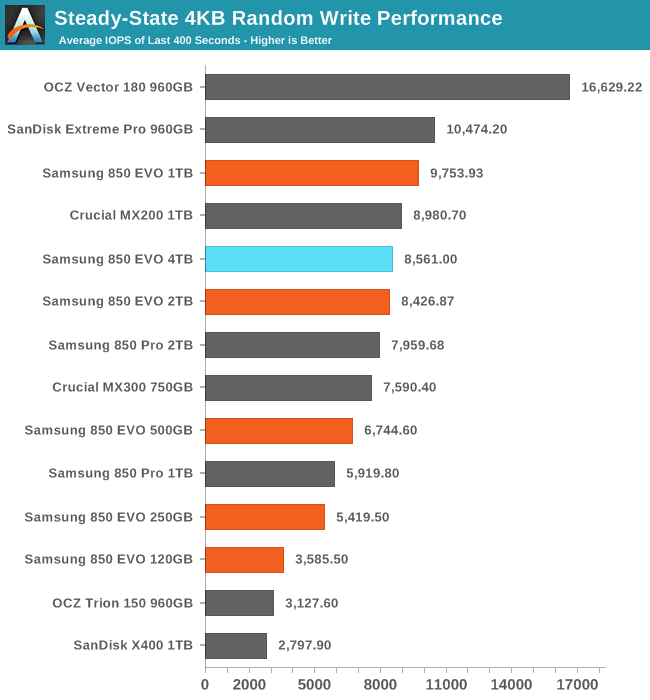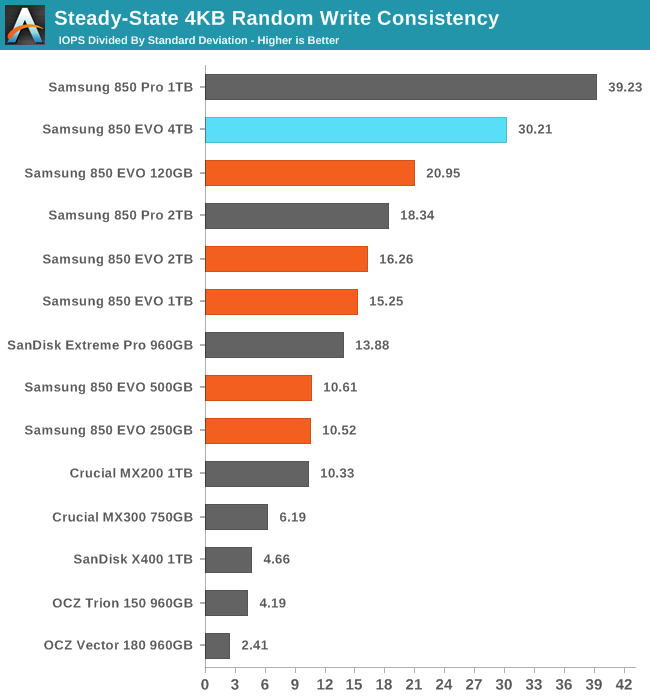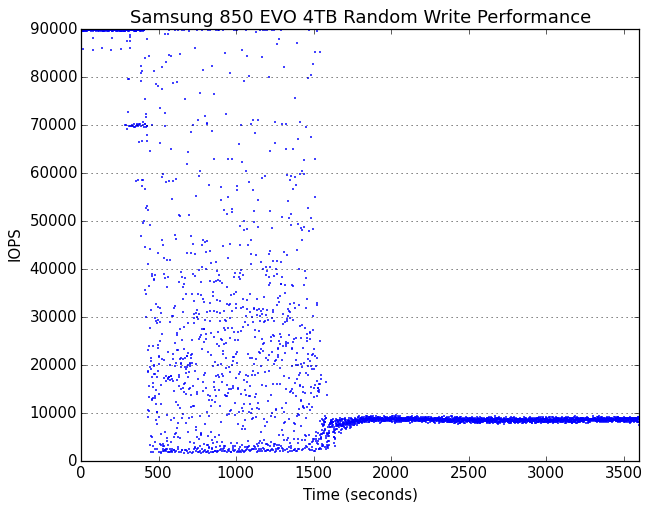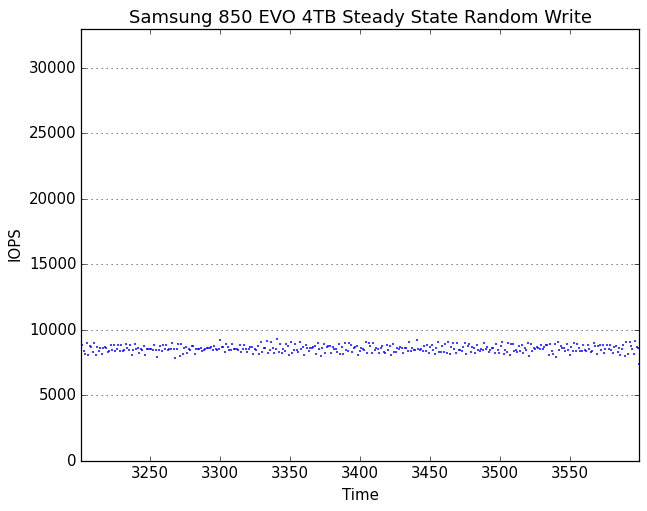The Samsung 850 EVO 4TB SSD Review
by Billy Tallis on July 11, 2016 10:00 AM ESTPerformance Consistency
Our performance consistency test explores the extent to which a drive can reliably sustain performance during a long-duration random write test. Specifications for consumer drives typically list peak performance numbers only attainable in ideal conditions. The performance in a worst-case scenario can be drastically different as over the course of a long test drives can run out of spare area, have to start performing garbage collection, and sometimes even reach power or thermal limits.
In addition to an overall decline in performance, a long test can show patterns in how performance varies on shorter timescales. Some drives will exhibit very little variance in performance from second to second, while others will show massive drops in performance during each garbage collection cycle but otherwise maintain good performance, and others show constantly wide variance. If a drive periodically slows to hard drive levels of performance, it may feel slow to use even if its overall average performance is very high.
To maximally stress the drive's controller and force it to perform garbage collection and wear leveling, this test conducts 4kB random writes with a queue depth of 32. The drive is filled before the start of the test, and the test duration is one hour. Any spare area will be exhausted early in the test and by the end of the hour even the largest drives with the most overprovisioning will have reached a steady state. We use the last 400 seconds of the test to score the drive both on steady-state average writes per second and on its performance divided by the standard deviation.

The 4TB 850 EVO restores a little bit of the performance that the 2TB lost relative to the 1TB, but Samsung's controller architecture is still clearly most comfortable at 1TB.

The consistency of the 2TB 850 EVO was only slightly better than the 1TB EVO, so it's surprising to see the 4TB model make such a large jump and come so close to the 1TB 850 Pro.
 |
|||||||||
| Default | |||||||||
| 25% Over-Provisioning | |||||||||
It is no surprise that a 4TB drive lasts so long before dropping out of peak performance: it has far more spare area to burn through than any ordinary consumer SATA SSD. The transition to steady state is uncharacteristically long and messy for a Samsung drive, and the performance lows during this period are disappointing. Once the drive has reached steady state, there's nothing to complain about.
 |
|||||||||
| Default | |||||||||
| 25% Over-Provisioning | |||||||||
There are no wild outliers from the 4TB 850 EVO's steady-state, and none of the longer-term drift in performance shown by the 1TB and 2TB 850 EVO and Pro models. With extra overprovisioning, the 4TB EVO carries on indefinitely with high and extremely steady performance.










145 Comments
View All Comments
profquatermass - Tuesday, August 9, 2016 - link
6GB? My first hard drive was 200MB!bug77 - Tuesday, July 12, 2016 - link
Yeah, if you can get one of these at half the MSRP, it's only $750 :rolleyes:Flunk - Monday, July 11, 2016 - link
It's only $0.36 a GB, that's pretty cheap.patrickjp93 - Monday, July 11, 2016 - link
You can get something like the Sandisk Ultra II 1TB for 21 cents/GB.ddriver - Monday, July 11, 2016 - link
But then again why would you? Unless you are starving, and if you are, then you wouldn't be buying SSDs...I can't honestly think of any good reason to buy something other than samsung SSD - they have the most warranty and performance is top notch too, reliability seems to be better too.
FLHerne - Monday, July 11, 2016 - link
Support and spec compliance. Samsung *still* ship firmware that claims support for queued TRIM ATA commands, but erases data if they're actually used. The consistent response is "Windows doesn't use these commands, we don't support other OS's", never mind that it's part of the SATA spec.(no, the kernel bug they fixed is completely unrelated)
I *hate* manufacturers treating "works in current Windows" as an acceptable spec - it's guaranteed to shoot you in the foot down the line, as everyone saw with Vista. So I bought a SanDisk instead.
FLHerne - Monday, July 11, 2016 - link
To clarify, I mean the way Vista broke all the manufacturers' stupid assumptions based on XP's behaviour.Also, the months it took for them to bodge around the performance degradation.
Notmyusualid - Tuesday, July 12, 2016 - link
Acutally, I hate to back up Microsoft, but they DID say it was a complete re-write of Windows, and that it would not be the same OS at all.It performed horribly with low amounts of RAM, and at the time, the big RAM makers were in collusion over RAM price fixing (look it up), so that is why we saw laptops, with Vista being shipped with 256MB of RAM, which was a mess, I agree.
But someone like myself, who had way more RAM than that, found it to be just fine. And it was way less infected than XP too.
I guess your printer never received a Vista driver then? Too bad.
But for me, and other client workstations with reasonable amounts of installed RAM I oversaw, it worked just fine, from the first day I used it.
Flame away...
kepler- - Wednesday, July 13, 2016 - link
Except they lied. Go onto your desktop and try to make a folder called "con". You can't, even on Windows 10, because they are still using code from Windows for Workgroups.There are a few others that (PRN, AUX, NUL, COM1...), which are all legacy Windows device names. They never '"rewrote" anything from the ground up.
Michael Bay - Thursday, July 14, 2016 - link
Oy vey, muh geschafts can`t go into appropriate folders now!Such shoah.